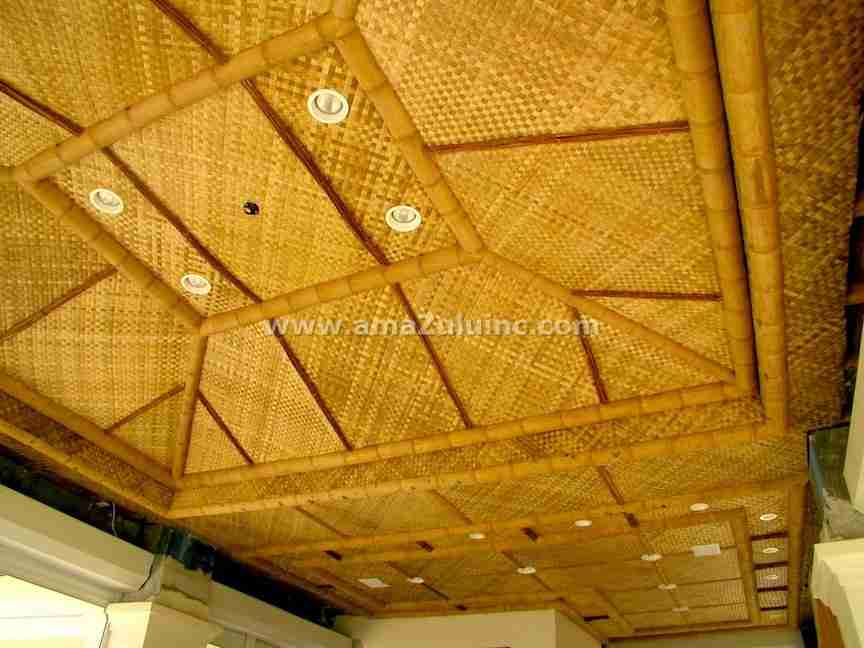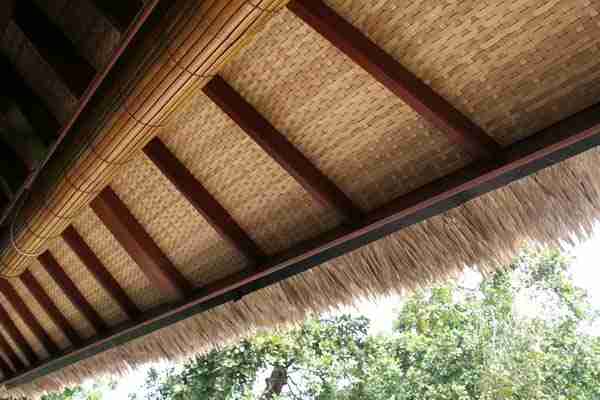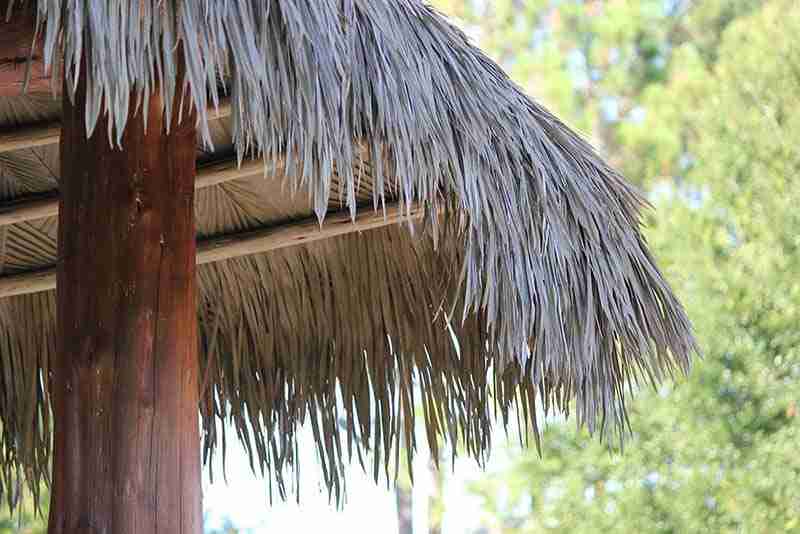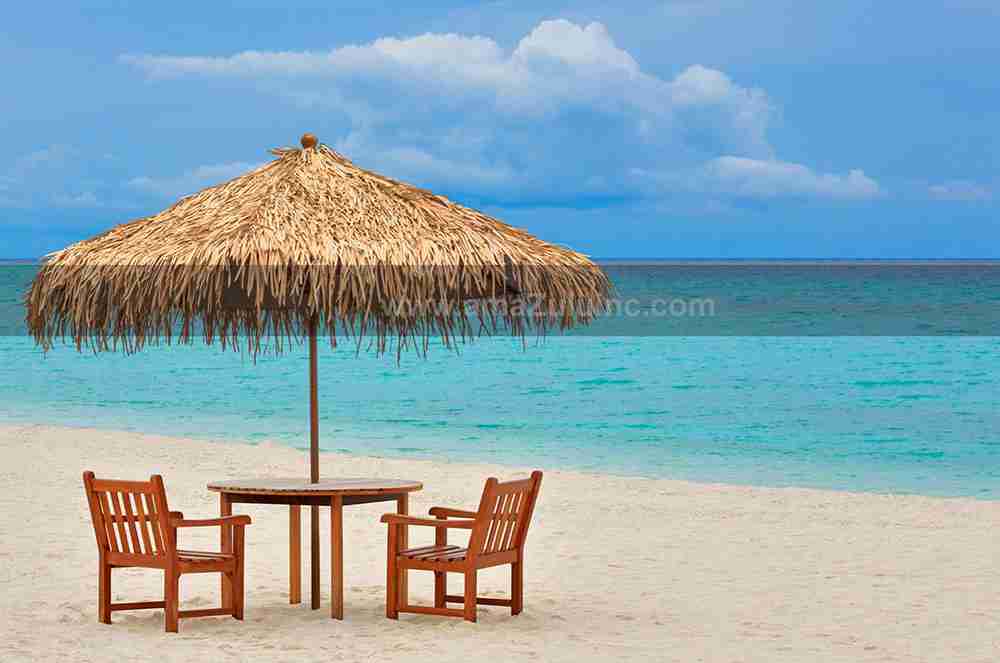Roof cabana design is more than just about shelter – it’s the crowning element that transforms a simple structure into a resort destination. From natural thatch that whispers tropical luxury to advanced synthetics that deliver decades of maintenance-free elegance, today’s cabana roofing options offer architects and designers unprecedented creative freedom.
Yet selecting the right cabana roofing solution requires understanding what materials are available, installation requirements, and performance factors. The choice impacts everything from guest experience and operational costs to sustainability goals and long-term maintenance needs. We’re here to help, so let’s dive in!
What Is a Cabana?
So what is a cabana exactly? If you ask Tristan Ishtar, vice president of sales at amaZulu, cabanas fit a very specific niche.
“When I think of a cabana, there’s going to be some kind of furniture in there, some towels, and it needs to be waterproof in case it rains – it’s more utilitarian,” Tristan says. “Cabanas tend to have sides, and they’re mostly associated with a pool or some type of recreation.”
This utilitarian nature, however, doesn’t mean sacrificing style. Modern cabanas serve as private retreats within public spaces, offering shelter, storage, and sophistication in equal measure. Unlike their open-air cousins like gazebos and pergolas, cabanas provide enclosed spaces that protect guests from both sun and rain while creating intimate environments for relaxation.
Roof Cabana Design Considerations for Commercial Spaces
If you’re a designer or architect for a resort or theme park, you have bigger challenges than someone putting one in their backyard near the pool. There are a few ins and outs that you will need to consider when determining the design for your cabana(s).
Structural Framework: The Foundation of Success
The basic architecture of a commercial cabana starts with a surprisingly simple framework. Four vertical poles and horizontal beams create the core structure, but the devil is in the details. Commercial applications demand materials that can withstand heavy daily use, resist environmental stressors, and maintain their appearance over time.
For resort and hospitality settings, the structural elements must balance visual lightness with commercial-grade durability. Size and spacing considerations play big roles in both the aesthetic appeal and functional success of the design, particularly when planning multiple cabanas for a single space.
Roofing Solutions: Beyond Basic Shelter
The roof of a cabana does more than just keep out rain – it’s a critical component that affects everything from temperature control to maintenance requirements. Modern designers can choose from several sophisticated options:
- Natural thatch delivers authentic tropical ambiance but requires more frequent maintenance
- Synthetic thatch products offer up to 20 years of low-maintenance performance while maintaining a natural appearance
Temperature management is a key consideration for any cabana roof. Traditional materials like thatch offer natural cooling properties, reducing temperatures beneath the structure by 10-15 degrees through natural air circulation. This passive cooling effect enhances guest comfort while potentially reducing climate control costs.
Side Enclosures: The Privacy Factor
The defining feature of a cabana lies in its enclosed sides, which transform an open shelter into a private retreat. Material selection for these enclosures demands careful consideration of both practical and aesthetic factors:
- Durable materials like eucalyptus poles provide natural beauty and structural integrity
- Synthetic panels offer consistent appearance and weather resistance
The enclosure design must balance the need for privacy with proper airflow, especially in humid poolside environments. Flexible solutions, such as retractable sides or adjustable panels, can provide adaptability while maintaining the structure’s core functionality.
Your Material Options for Roof Cabana Design
The success of your cabana project often hinges on selecting the right roofing material. This choice affects not only the structure’s appearance but also its longevity, maintenance requirements, and overall project costs. Let’s examine the key options available for commercial applications.
Natural Thatch: Traditional Appeal Meets Modern Applications
Natural thatch delivers an unmatched authentic appearance that instantly transports guests to a tropical paradise. While its limited lifespan in outdoor settings requires more frequent replacement, the material remains cost-effective and environmentally conscious.
Proper installation techniques can maximize its durability, and when it reaches the end of its lifecycle, natural thatch can be fully recycled, supporting eco-friendly initiatives.
Synthetic Thatch: Durability Meets Design
Modern synthetic thatch options have really changed commercial cabana design. Products like Viva Palm and Viro Palm offer the aesthetic appeal of natural materials with significantly enhanced durability. These high-density polyethylene solutions provide up to 20 years of service life while maintaining their appearance across various climate conditions.
The synthetic options include:
- Viva Palm Thatch: Simulates natural palm with UV stabilization
- Viro Palm Subroof: Ideal for layering over existing structures
- Viro Reed: Offers a distinct, multi-colored appearance for unique designs
Environmental Impact and Sustainability
Both natural and synthetic thatch options support environmental initiatives. Synthetic materials are fully recyclable and can contribute to LEED certification points, while natural materials offer a completely biodegradable solution. This environmental consciousness extends beyond the materials themselves to installation methods that minimize waste and maximize efficiency.
Commercial Installation and Maintenance of Cabana Roofs
The practical aspects of cabana construction and maintenance significantly impact long-term success.
Installation Considerations
While basic cabana construction may seem straightforward, commercial applications demand attention to specific requirements.
“Four vertical poles and horizontal beams might be the foundation,” notes Tristan, “but the complexity comes from how you want to finish it – whether with solid eucalyptus on the sides or other materials.”
Professional installation ensures structural integrity and warranty compliance, particularly important for commercial properties where there are liability concerns.
Maintaining Long-Term Value
A well-designed cabana requires minimal maintenance when properly constructed with the right materials. Synthetic thatch options are great for this, requiring only basic cleaning and occasional inspection. Weather resistance comes built into modern materials, while proper ventilation design helps prevent moisture-related issues.
Safety and Structural Integrity
Commercial cabanas must meet specific safety requirements, including:
- Fire-retardant treatment options for roofing materials
- Storm resistance ratings appropriate for the location
- Structural design that ensures guest safety
Got a Roof Cabana Design Project? We Can Help
Your cabana project deserves expert guidance from concept to completion. amaZulu’s design consultants offer complimentary consultations to help you navigate material selection, technical specifications, and design considerations. With decades of experience in commercial tropical design elements, we understand the unique challenges and opportunities your project presents.
Contact amaZulu today at 877-243-5309 to schedule your free consultation and discover how our expertise can help bring your vision to life. From material samples to detailed specifications, we’ll provide everything you need to make informed decisions about your cabana project.





